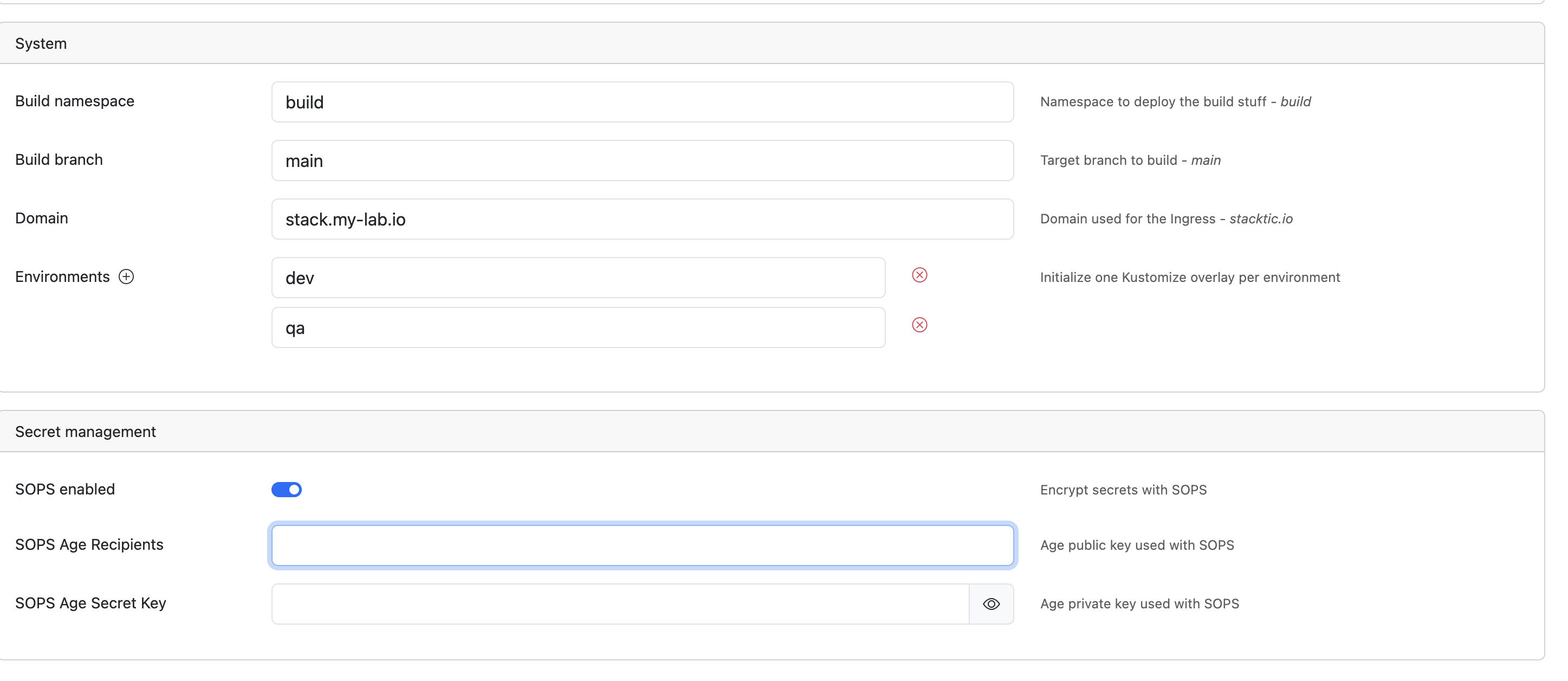Quick Start Guide
Quick Summary - Get started with Stacktic in minutes. This guide walks you through creating your first automated full-stack application from design to deployment.
Before You Begin: Make sure you've reviewed the Prerequisites to ensure your environment is ready.
What is Stacktic?
Stacktic is a metadata-driven automation platform that transforms your application topology designs into complete, production-ready repositories. Simply drag and drop components to design your stack, and Stacktic automatically generates all configurations, deployments, security policies, and operational files.
The Three-Layer Platform Engineering Architecture
How it works:
- You design the topology - Drag and drop components in the Stacktic UI to visualize your architecture
- Stacktic understands relationships - From your topology design, Stacktic automatically identifies component dependencies and determines what operational configurations need to be generated
- Three-layer automation executes:
| Layer | What It Does | Result |
|---|---|---|
| 1. Integration | Connects components (source code, Helm charts, frameworks, tools, packages, open source) | All components integrated and ready |
| 2. Relationships | Automates connections between components (databases, messaging, data pipelines, APIs) | Secure, configured relationships |
| 3. Full-Stack Operational | Builds production-ready applications with versioning, security, validation, and operations | Complete deployable stack |
The outcome: Production-ready, fully managed stacks with built-in versioning, control, security, and operational automation—all generated from your visual topology design.
Key Features
| Feature | What You Gain |
|---|---|
| Automated Relationships | Service links and dependencies are mapped for you—no manual YAML |
| Metadata-Driven | Declarative metadata eliminates human error and operational drift |
| Full-Stack Version Control | Roll back or branch entire environments, not just code |
| Autonomous Security | RBAC, NetworkPolicy, and OPA rules generated at build time |
| Cloud-Agnostic Migration | Import workloads from VMs, managed services, or Docker to Kubernetes in minutes |
| Stack Awareness | Stack layers and relationships awareness, Audit Report, SecOps test automation and more |
Generic Version Control Approach
Stacktic centralizes complexity by turning full-stack relationships into versioned, automated building blocks.
Supported Workflows
| Workflow | Description |
|---|---|
| Topology Design | Visual drag-and-drop architecture |
| Data Flow Management | Automated pipeline configuration |
| SecOps Automation | Security policies and compliance |
Who Uses Stacktic?
Developer • Architect • DevOps • SecOps • SRE • CISO teams
How It Works
High-Level Workflow
| Step | Action | Output |
|---|---|---|
| 1. Design Topology | Drag components and connect them | Visual architecture diagram |
| 2. Extend with Logic | Add custom automation rules, observability, SecOps | Enhanced configuration |
| 3. Generate Stack | Click Build | Git skeleton (k8s/, scripts/, dashboards, secrets) |
| 4. Deploy | Apply to cluster | Complete E2E stack running |
Automation Examples
| Scenario | What Stacktic Generates |
|---|---|
| Source Code → Database | Creates DB & user, injects connection string as Secret |
| RAG & AI | Automate private Llama maintenance and security, cache models, automate RAG & Data feed |
| ETL | Link DAG to databases, simplify ETL and data flow to drag and drop |
| Kafka Topic → Database | Provisions topic, ACLs, and KafkaConnect sink |
| Policies Automation | RBAC, NetworkPolicy, and OPA Gatekeeper rules via toggles |
Getting Started
Step 1: Understanding the Automation
Please watch (3 min)
Step 2: Access Stacktic Platform
| Action | URL |
|---|---|
| Sign In | https://staging.app.stacktic.io/ |
| Create or Select Stack | https://staging.app.stacktic.io/systems |
Step 3: System Configuration
Configure Docker registry and GitHub integration.
Important: Use tokens instead of passwords and always test connections before proceeding.


SOPS Support (Optional)
Enable encryption by adding your Age public key for secret management:

Designing Your First App
- Drag-and-drop a backend and a database, then connect them.
- Build (first time) – choose Build, not FastBuild, to create the full repo.
- Merge strategy – The
stackticbranch is the generated skeleton;mainis yours. Automatic merges respect your custom edits.
Deployment
Build and Deploy Steps
-
Clone Repository
git clone https://github.com/yourusername/your-stacktic-repo.git
cd your-stacktic-repo -
Build Images
kubectl apply -k k8s/build/overlays/dev/ --server-side=true --force-conflicts=true -
Deploy Stack
kubectl apply -k k8s/deploy/overlays/dev/ --server-side=true --force-conflicts=true -
Check Deployment
kubectl get pods -n build
kubectl get apisixroute -A
Source Code Integration Options
Migration Guide
Database Migration
- Manual Restore: Copy DB dump to running pod and restore
- MinIO-Based Restore (Recommended): Upload dump to MinIO bucket and link to database
- InitDB Setup: Use application-driven schema creation or initdb scripts
Continuous Updates
Use FastBuild for incremental updates when adjusting specific component values without changing relationships.
Examples
- Kafka Connect Setup: https://github.com/stackticio/strimzi_basic_setup/tree/main
- Llama Integration: https://github.com/stackticio/Llama_base/tree/main
Resources
- Q&A: https://www.stacktic.io/differentiators
- ROI Examples: https://www.stacktic.io/roi
- Blog: https://www.stacktic.io/blog
- Demos: https://www.stacktic.io/demos
Support
- Support: support@stacktic.io
- General Inquiries: info@stacktic.io
License
© 2025 Stacktic. All rights reserved. This technical guide is protected by copyright law. Contact for licensing or permissions.
Ready to automate with Stacktic? Our open platform enables custom logic automation for any use case. Integrate your tools, unify relationships, and automate exactly what you need.